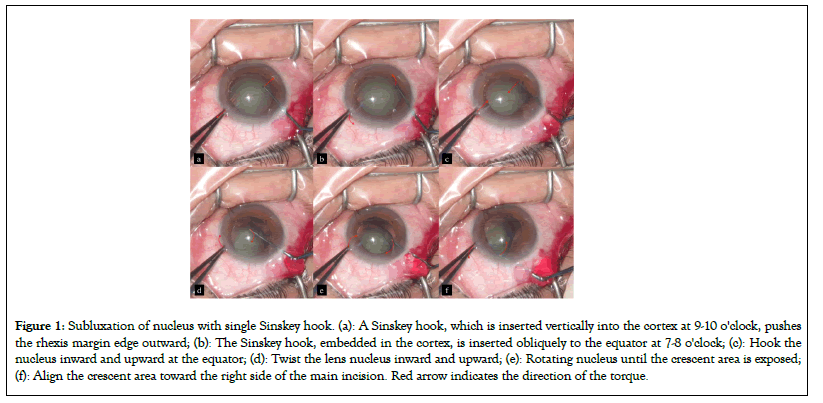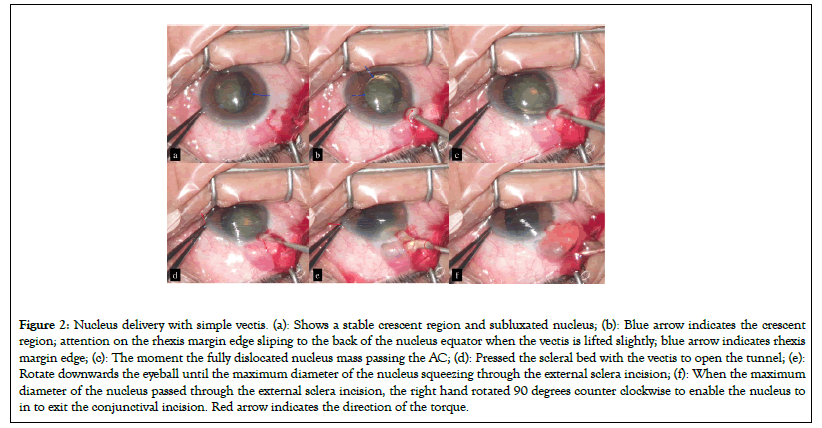Journal of Clinical and Experimental Ophthalmology
Open Access
ISSN: 2155-9570
ISSN: 2155-9570
Research Article - (2023)Volume 14, Issue 5
Nucleus extraction remains a crucial step in Manual Small-Incision Cataract Surgery (MSICS). Here we describe a subluxated nucleus extraction technique without additional hydro-procedures. We demonstrate how a nucleus can be maneuvered safely out of the capsular bag and through the tunnel with a Sinskey hook and simple vectis without hydrodissection or hydrodelineation. This technique is time-tested with good results and more than 95% of nuclei in Sub-Conjunctival Oblique Limbus Incision (SCOLI) are extracted in this way with the benefits of economical usage of viscoelastic, simplified surgical procedure, and minimal damage to the pupil and corneal endothelium and lower cost.
Nucleus extraction; Sub-conjunctival limbus; Technique; Corneal endothelium
The surgery has evolved from Extra-Capsular Cataract Extraction (ECCE) to Manual Small-Incision Cataract Surgery (MSICS) and phacoemulsification. Phacoemulsification became popular in early 1990, and MSICS took a stride forward in early 2000 [1]. In MSICS, safe and whole nucleus extraction remains a crucial step and a challenge [2]. It is also the process in which serious complications occur easily, especially with a large, dense nucleus [3]. Hydroexpression of nucleus with an irrigating vectis is a conventional technique which uses a combination of mechanical and hydrostatic forces to express out the nucleus [4]. The irrigating vectis available in various shapes and sizes, is attached to a 5-cc syringe containing Balanced Salt Solution (BSS). Viscoelastic is injected above and below the nucleus to protect the endothelium and push the iris diaphragm and posterior capsule posteriorly. The technique is suited for removal of softer cataracts, while harder cataracts are removed by increasing the size of the scleral tunnel [5].
We reported previously a modified cataract surgery incision called Sub-Conjunctival Oblique Limbus Incision (SCOLI), which has a specially designed incisional architecture that enables a large nucleus to pass through [6-8]. Here, we describe in detail the technique for nucleus extraction in SCOLI surgery, which improves the safety and ease of performance of the SCOLI technique.
Surgical technique
The SCOLI surgery was done in topical anesthesia without placing a superior rectus bridle suture. Ideally, a rhexis size of 6.0 mm to 6.5 mm would be required for dense nuclei, whereas a rhexis of 5.5 mm to 6.0 mm should suffice for less dense nuclei. Arter capsulorrhexis, hydrodissection was not performed.
Sub-luxtion of nucleus
Single Sinskey hook method: A Sinskey hook, which is passed through the main incision, translated to the equator of the nuclear mass tracing the surface of the nucleus, pushed slightly against the rhexis margin edge 9-10o'clock outward as shown in Figure 1A, then it is inserted obliquely to the equator to engage the substance of the nucleus 7-8 o'clock equator as shown in Figure 1B and immediately turned posteriorly to the lens equator. At this stage, the nucleus was rotated clockwise and lifted upward onto the iris pupillary plane until the temporal equator of the nucleus could be seen over the capsular margin as shown in Figures 1C and 1D. When the plane between the nuclear mass and the capsular opening reached 45 degrees, and a crescent-shaped area was seen between the edge of the nucleus and the upper right pupil edge as shown in Figures 1E and 1F. Without dislodging entirely into the Anterior Chamber (AC), the sub-luxated nucleus gets stuck between the capsular openings (Figures 1A-1F).

Figure 1: Subluxation of nucleus with single Sinskey hook. (a): A Sinskey hook, which is inserted vertically into the cortex at 9-10 o'clock, pushes the rhexis margin edge outward; (b): The Sinskey hook, embedded in the cortex, is inserted obliquely to the equator at 7-8 o'clock; (c): Hook the nucleus inward and upward at the equator; (d): Twist the lens nucleus inward and upward; (e): Rotating nucleus until the crescent area is exposed; (f): Align the crescent area toward the right side of the main incision. Red arrow indicates the direction of the torque.
Nucleus delivery with simple vectis
After confirming patency as shown in Figure 2A, with or without adding Ophthalmic Viscosurgical Device (OVD) beneath the mass, a 4.5 mm wide vectis was insinuated with concave-side anterior under the nucleus, into the central lower nucleus, by tilting 45 degrees as shown in Figure 2B. The surgeons rotated the eyeball left down while gently lifted the lower part of the nucleus with the vectis. On noticing the lower anterior capsule sliding to the equator below the mass, we further rotated down the eyeball and supported the nuclear mass with the vectis. At this stage, the fully dislocated nucleus mass entered the inner incision via the anterior chamber as shown in Figure 2C. We slowly pulled the vectis while alternately pressed the scleral bed as shown in Figure 2D. When two-thirds of the nucleus came into the tunnel, we continued to rotate downwards the eyeball until the maximum diameter of the nucleus passed through the external sclera incision as shown in Figure 2E. At this time, the left hand stopped rotating down and the right hand rotated 90 degrees counterclockwise to enable the nucleus to in to exit the conjunctival incision as shown in Figure 2F. In the entire nucleus extraction session, no hydrodissection or hydrodelineation was done, and in most cases viscoelastic was added only once. Finally, being driven by the increased intraocular pressure and pulled by the vectis, the whole nucleus was dislodged out of the eyeball (Figures 2A-2F) see video.

Figure 2: Nucleus delivery with simple vectis. (a): Shows a stable crescent region and subluxated nucleus; (b): Blue arrow indicates the crescent region; attention on the rhexis margin edge sliping to the back of the nucleus equator when the vectis is lifted slightly; blue arrow indicates rhexis margin edge; (c): The moment the fully dislocated nucleus mass passing the AC; (d): Pressed the scleral bed with the vectis to open the tunnel; (e): Rotate downwards the eyeball until the maximum diameter of the nucleus squeezing through the external sclera incision; (f): When the maximum diameter of the nucleus passed through the external sclera incision, the right hand rotated 90 degrees counter clockwise to enable the nucleus to in to exit the conjunctival incision. Red arrow indicates the direction of the torque.
The crux of the Manual Small-Incision Cataract Surgery (MSICS) is nucleus management. Various methods of prolapsing the nucleus from the capsular bag into the Anterior Chamber (AC) and extraction of it from the eye have been demonstrated. Conventionally, a fluid bolus is injected under the rhexis margin edge (forceful hydrodissection) to help prolapse of the cataractous lens into the AC, resulting in Ophthalmic Viscosurgical Device (OVD) loss. After luxation of the nucleus into the anterior chamber, Ophthalmic Viscosurgical Device (OVD) is re-supplemented above and below the nucleus as a maintain agent [7,8]. We have explored a novel hydro-free subluxation technique and have made it a proficient technique in our Sub-Conjunctival Oblique Limbus Incision (SCOLI) surgery practice that gives good clinical results.
We characterize the hydro-free subluxated nucleus management technique as follows. The first step is to prolapse the nucleus from the capsular bag. Experience from our and other surgeons is that separation of the nucleus from the cortex or separation of the cortex from the capsule bag could be accomplished by only mechanical force using single or two auxiliary instruments. The nucleus could be dialed out of the capsular bag by engaging the equator with a single Sinskey hook. Hydroprocedures are no longer important in the manual small incision surgery. Actually, it might be possible to prolapse any lens with a hard core using this technique.
Compared with luxation, in which the lens is prolapsed completely into the anterior chamber, the subluxated nucleus stays one pole in the capsular bag and the other in the anterior chamber, which means, it is less likely to injure the endothelial cells and the iris, less occupation the space of the anterior chamber. The crescent-shaped area appearing between the subluxated nucleus and the upper-right pupil edge enables the entire extraction procedure to be performed under direct view.
After luxation of the nucleus out of the capsular bag, nucleus extraction is required. Hydro-expression with irrigating vectis is the standard textbook method, in which miosis is the most common intraoperative complication. However, the hydrostatic pressure builds up by the irrigating vectis could be replaced by a pressure gradient creating by rotating down the eyeball and intermittently pressing the scleral bed when the inner tunnel is blocked by the nucleus mass.
Hydro-free nucleus delivery technology avoids re-supplementing a viscoelastic agent after hydrodissection, omits unnecessary steps, and improves surgical efficiency. The subluxated nucleus is introduced directly into the tunnel without staying in the Anterior Chamber (AC), minimizing damage to the pupil and corneal endothelium.
This nucleus extraction approach represents a single instrument technique. The operating eye is stabilized with toothed forceps during the whole procedure, ensuring safety under topical anesthesia even with a lack of cooperation from the patient. Furthermore, the left hand helps to build up pressure gradient and facilitate nucleus delivery while preventing the nucleus from rubbing on the endothelium.
This technique has advantages over the conventional irrigating vectis technique and other methods of nucleus extraction. Advantages include the use of a single instrument with single hand, formed anterior chamber throughout the procedure, simplified surgical producer. Complications include the risk of iridodialysis, posterior capsular rupture and zonular dialysis. These complications can be prevented by ensuring proper visualization and improved surgery technique [9].
Nucleus extraction with a hydro-free subluxated represents a simplified technique designed for SCOLI and other MSCIS, in which we use mechanical forces to express out the nucleus without hydro-expression procedures. This technique is time-tested with good results and more than 90% of nuclei in our over forty-thousand cases of Sub-Conjunctival Oblique Limbus Incision (SCOLI) surgeries are extracted in this way. It is a promising alternative to the procedures described previously for cases with a moderate to hard nucleus.
Sub-Conjunctival Oblique Limbus Incision (SCOLI) by hydro-free subluxated technique is a good alternative to other techniques of nucleus management in terms of universal applicability, formed anterior chamber, simplified surgical producer with earlier visual rehabilitation and cost-effectiveness in the developing world. In this nucleus extraction procedure, both prolapse of nucleus procedure and nucleus delivery can be accomplished by mechanical force. The omission of the hydro-expression procedure and avoiding complete luxation of the nucleus into the Anterior Chamber (AC) makes Manual Small-Incision Cataract Surgery (MSICS) safer and more efficient, especially for Sub-Conjunctival Oblique Limbus Incision (SCOLI).
This study was supported by the Key Projects of Jiangxi Traditional Chinese Medicine Science and Technology Program (Grant No. 2021Z014) and Jiangxi Provincial Health Commission Science and Technology Program (Grant No. 20195046).
[Crossref] [Google Scholar] [PubMed]
[Crossref] [Google Scholar] [PubMed]
[Crossref] [Google Scholar] [PubMed]
[Crossref] [Google Scholar] [PubMed]
[Crossref] [Google Scholar] [PubMed]
[Crossref] [Google Scholar] [PubMed]
Citation: Yang J, Lai P, Han F, Huang X, Jiang Y (2023) A Hydro-Free Subluxated Technique for Nucleus Extraction in Sub-Conjunctival Oblique Limbus Incision Cataracts Surgery. J Clin Exp Ophthalmol. 14:959.
Received: 28-Aug-2023, Manuscript No. JCEO-23-25834; Editor assigned: 30-Aug-2023, Pre QC No. JCEO-23-25834 (PQ); Reviewed: 13-Sep-2023, QC No. JCEO-23-25834; Revised: 20-Sep-2023, Manuscript No. JCEO-23-25834 (R); Published: 29-Sep-2023 , DOI: 10.35248/2155-9570.23.14.959
Copyright: © 2023 Yang J, et al. This is an open-access article distributed under the terms of the Creative Commons Attribution License, which permits unrestricted use, distribution, and reproduction in any medium, provided the original author and source are credited.